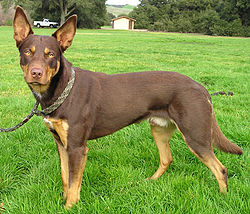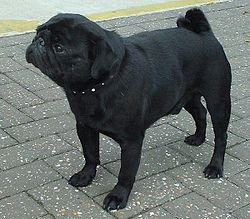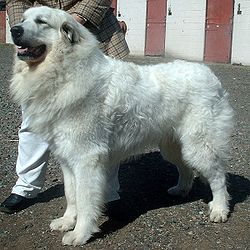Dog Care/Obesity



Dogs, like people, can become overweight if they eat more calories than they burn through activity. And, just as obesity can cause health problems in humans, it can cause health problems in dogs, including early arthritis, heart problems, diabetes, and much more. Because dogs' lifespans are so short to begin with, allowing a dog to become obese can significantly shorten its life.
For purebred dogs, you can get an estimate of a healthy weight for the dog by reviewing the breed standards published for that breed. Typically, male dogs are slightly larger and therefore weigh slightly more than females of the same breed.
For all dogs, including mixed-breed dogs or purebred dogs whose height falls outside the breed standard, it is easy to determine whether it is of a healthy weight as follows:
- By feeling along its sides, you should be able to feel the spaces between a dog's ribs without by just lightly running your hands along its sides, pressing only hard enough to feel through the hair coat. If you can't feel the ribs, your dog is obese and needs to eat less.
There should not be deep indentations between ribs, or the dog needs more calories (more or higher quality dog food).
- By feeling along its back, you should be able to just barely feel the vertebrae in a dog's spine when you run your fingers along the back without pressing (or pressing just hard enough to feel through the fur of a dog with a thick coat).
- By looking down on the dog from above as the dog is standing. The dog's waistline should be thinner than its chest and hips. You should be able to feel the hip bones with a little fat overlying them. (Sharp hip bones means your do is too skinny.)
- By visual inspection from the side. For short-coated dogs, such as Boxers or Chihuahuas, you should be able to just barely see the light outline of the ribs through the coat, but they should not be obvious. In any dog, the abdomen should be tucked up instead of horizontal toward the rear.
Although all dogfoods include printed suggestions for serving sizes for dogs, you must adjust the serving size depending on the amount of exercise that the dog gets and how many other sources of calories the dog has, such as plentiful treats, table scraps after every meal, and so on. As a rule, dogs should have less than five percent of their diet in treats and table scraps and at least 95% quality commercial dog food. Many pet food labels exaggerate how much food your dog needs. Ask your veterinarian for a more reasonable suggestion, or feed just enough to keep your dog in good condition, as judged by the criteria above.
If you do feed table scraps, avoid grapes, raisins, and chocolate, which are highly poisonous to dogs. Never feed uncooked meat, as dogs are just as likely as humans to get food poisoning. (It is very difficult to make a homemade diet as complete as a commercial diet... dogs need to eat mostly dog food.)
Additional information
[edit | edit source]- List of dog breeds for links to breed info, often with size and weight, and with links to breed standards
- Important information on the Menu Foods Dog and Cat food recall
